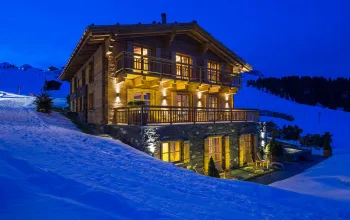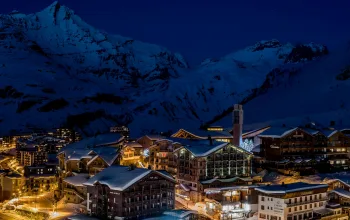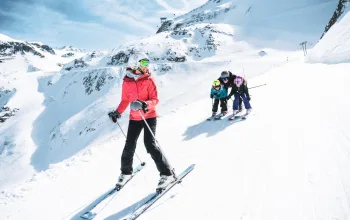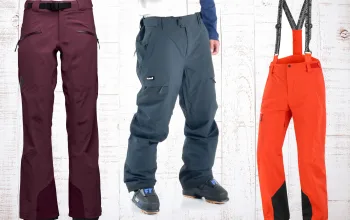Ever wanted to get away from the crowds? Ski touring offers just that, with only those prepared for a long walk being rewarded with a powder paradise. There is nothing quite like waking in a mountain hut, far away from the crowds; refuelling, and then heading out into the bright high alpine landscape for a day of solitude amongst the peaks.
So with the help of off-piste experts ‘Mountain Tracks’, we’ve pulled together our Top Ten classic European multi day tours. Here - in no particular order - are the 10 tours we like the most, and we hope they inspire you to ‘put your skins on’!
1- Chamonix to Zermatt: The Haute Route
Country: France and Switzerland
Start Point: Chamonix
End Point: Zermatt
Nearest Airport: Geneva
Length of Tour: 5-6 days skiing
Possibly the most famous ski tour in the world, the Haute Route, literally meaning ‘high route’ is a journey that every ski touring enthusiast should undertake at least once in their life. The linking of the two historic alpine centres, Chamonix and Zermatt, takes 5 or 6 days, depending on the route taken. A longer opinion is available with Grand Lui or Saas extensions. The route traverses two sections of the highest Alpine ranges: the Mont Blanc Massif and the Swiss Valaisgreat, with most of the tour being above 3000m. At such height the route is mainly on huge glaciers, crossing over high and often steep passes. The challenging and ever changing landscape of this tour is true joy to behold. There are two route choices for the middle section of the tour: The Verbier variant and the Valsorey variant. The Verbier route is easier and by far the most popular, where as the Valsorey variant has more climbing and a technical ascent/ traverse called the Plateau du Couloir, which requires reasonable weather and fairly stable snow conditions.
How difficult is this tour?
For fit and advanced skiers. 1000m – 1200m of ascent per day. The length of each day varies between 6 -10 hours. The downhill skiing is never steeper than 35 degrees, but the descents are long and in variable snow.
2- Traverse of the Central Bernese Oberland
Country: Switzerland
Start Point: Gridelwald
End Point: Munster or Grimsel at the head of the Rhone valley.
Nearest Airport: Geneva or Zurich
Length of Tour: 5-6 days skiing
Home of the Eiger, the Bernese Oberland range is located in the high peaks of central Switzerland. The Bernese Oberland boasts a landscape complete with giant glaciated valleys, more akin to Alaska than the Alps. This classic tour, typically attempted over a week, crosses the massif from north to south. The tour is one of the very best in the Alps with classic views of the Jungfrau, Mönch, and the Eiger. The majority of the tour is on huge tumbling glaciers which collide at the source of the giant Aletschgletscher, the largest glacier in the Alps. As you need never return to the valley floor, it’s a great trip for late in the season, when all the lower snow has melted. There is also the opportunity to make several descents of many summits, including some 4000m plus peaks.
How difficult is this tour?
For fit intermediate off-piste skiers and above. Previous ski touring experience is essential, skiers should be happy to skin for 4-5 hours per day. Most of the descents are not particularly steep (30 degrees and under) but high mountain dangers are present. A good level of fitness is required in order to sustain six days of consistent effort.
3- Elbrus
Country: Russia
Start Point: Adyrsu Valley
End Point: Terskol
Nearest airport: Mineralny Vody
Length of Tour: 8 days skiing
Splitting Georgia from Russia, the Caucasus mountains - famed for Europe’s highest summit , the twin-peaked Mount Elbrus - is a fascinating place to tour. The main Caucasus chain itself contains many mountains over 5000m. In spring time the Caucasus offer exceptionally fine ski-touring and even the chance of an ascent of Elbrus; which at 5642m is over 800m higher than the summit of Mont Blanc, making a structured acclimatisation period essential. Acclimatisation begins at the Ullu-Tau lodge, located at 2350m in the remote Adyrsu Valley. This beautiful valley is covered in glaciers, and runs beneath numerous summits, ranging from 3572m to 3900m. After four days touring in the Adyrsu Valley, you transfer, by minibus, to the Baksan Valley. At the head of the Baksan Valley, at the foot of Elbrus itself, lies the town of Terskol - the Chamonix of the East. Hopefully acclimatised, the next section of this tour focuses on the ascent of Elbrus. The ascent route is none technical but very strenuous, with the high altitude being the most difficult obstacle to overcome. The ski terrain on Elbrus itself is relatively straightforward, but exciting and exceptionally long; an amazing 3000m descent is possible from the summit.
How difficult is this tour?
For fit and advanced skiers. 1200m – 1800m of ascent per day. The length of each day varies between 7 -12 hours. The touring is at higher altitudes than in the Alps so optimum fitness is essential. The downhill skiing is never steeper than 35 degrees, but the descents are long and in variable snow. Crampons and ice axes may be required on the upper slopes which are easy angled but often icy in the morning hours.
4- The Gran Paradiso National Park
Country: Italy
Start and finish point: Valsavarenche valley, close to Aosta
Nearest Airport: Geneva or Turin
Length of Tour: 3-6 days
The Gran Paradiso (at 4061m, the highest mountain entirely within Italy) benefits form sitting within one of the most idyllic National Parks in the Alps. This hut to hut tour circumnavigates the massif and cumulates with an ascent of the Gran Paradiso. The trails are generally quieter than in France and Switzerland and when combined with friendly Italian hospitality it all adds up to a great week's ski touring and eating. The massif is accessed via the Aosta Valley, which stretches south from Mont Blanc. Utilising the areas tranquil mountain village, where fine traditional Italian mountain food can be enjoyed, along with great coffee and a rich offering of good wines this tour is a real joy, and due to its national park status, the plant and wild life are protected so the tour itself is a paradise for nature lovers. There is no ski infrastructure in the National Park, making for a true wilderness experience, and to reach the summit of the Paradiso itself (4061m) takes a strenuous climb, with a short rock scramble. However all the effort is worthwhile as you are rewarded with a descent of over 2000m.
How difficult is this tour?
For fit, upper intermediate, off-piste skiers. 700m – 1300m of ascent per day. The length of each day varies between 6 -10 hours. The downhill skiing is never steeper than 35 degrees, but the descents are long and in variable snow. Crampons are ice axes are required for the final ridge of the Gran Paradiso.
5- The Italian Haute Route
Country: Italy and Switzerland
Start Point: Cervinia
End Point: Zermatt
Length of Tour: 5-6 days
Often referred to as the ‘Spaghetti tour’, this challenging hut to hut tour traverses the Monte Rosa chain. Situated on the Swiss Italian border, the Monte Rosa massif has the highest land area in the Alps, over 4000m. There is an element of mountaineering in this voyage, so in addition to being a strong skier, tourers should also be able to handle an axe and crampons. It is possible for skiers to summits on several 4000m peaks within this massif and exciting descents are guaranteed. The highest point in the Monte Rosa Massif is the Dufourspitze (4634m), which is the second highest mountain in the Alps. It is possible to ascend with skins to within the last hundred meters of this summit, with the top section requiring mountaineering skills.
There is a mix of Italian and Swiss mountain huts on this tour, all of which are comfortable and serve hearty meals amongst the regions stunning mountain. The tour can also include a stay in the famous Margherita hut, which at 4556m is the highest in the Alps.
How difficult is this tour?
For fit, advanced skiers with mountaineering skills. 700m – 1800m of ascent per day. The length of each day varies between 6 -12 hours. This is one of the most challenging of the classic tours, with a combination of long ascents and steep slopes (some above 35 degrees). In addition crampons and ice axe are used for sections of the journey to negotiate areas of ice and rock.
6- Pyrenean Haute Route
Country: France and Spain
Start Point: Luz St Sauveur
End Point: Gavarnie
Nearest airports: Lourdes or Toulouse
Length of Tour: 6 days
The high Pyrenees are often overlooked by ski tourers, but this is a mistake, as a huge selection of options awaits in this extensive mountain chain. Our favourite choice, in these border mountains, would be a circuit of the Pyrenees National Park with an ascent of highest peak in the French Pyrenees, the Vignemale (3289m). The Pyrenees have more of a rustic feel than the Alps, with traditional ways of mountain life still prevalent. However ski touring has become more popular here, and to respond, the hiking refuges are now open to trade early in the spring. This hut to hut route utilises a section of the long distance walking route, GR10, which criss-crosses the French/Spanish border. As well as the pure beauty of the route, there is also historical significance, as several of the major passes were used heavily in World War II and the Spanish Civil War. A highlight for many is the ascent of the highest peak in the French Pyrenees: Vignemale (3289m), and also crossing through the dramatic ‘rock door’ to Spain via the Breche de Roland. So as to use the huts, this tour normally runs in the spring and the sun can be strong this far south, so superb spring snow conditions can often be found early in the afternoon.
How difficult is this tour?
For fit intermediate skiers. Tourers should be happy to skin for 4-5 hours per day. 600m–1100m of ascent per day. A good level of fitness is required in order to sustain six days of consistent effort.
7- The Austrian Alps: Silvretta Traverse
Country: Austria
Start Point: Landeck
End Point: Galtür
Nearest Airport: Innsbruck
Length of tour: 5-6 days
The classic Silvretta Traverse is a great introduction to hut-to-hut ski touring, as there is huge choice of excellent skiable peaks and the area can boast a fantastic snow reliability. The fully serviced huts are very comfortable offering hot showers, great beer and a hearty feed. The terrain is glaciated, and on some summits will need to use crampons and ice axe to reach the top, but with the help of your guide no previous mountaineering experience is necessary - just a bit of mountain confidence.
The Silvretta Range is located along the Swiss-Austrian border, just south of the well-known resort of Saint Anton and the entire massif is covered with large but gentle glaciers and accessible cols. The terrain is particularly user-friendly to the ski tourer, with many of the summits lower than in the Western Alps - typically around 3000m to 3300m - making it possible to skin right to the top of the high summits, whereas in the Western Alps many of the high peaks demand mountaineering approaches. The route journeys from east to the west, each day crossing high passes before dropping down into the next valley system. The touring season starts here early to mid-Febuary, making the Silvretta Traverse a great opener to your seasons ski touring. How difficult is this tour?
For intermediate off-piste skiers. Touring skill can be learned on-route. 600m–1000m of ascent per day. The length of each day varies between 5 -8 hours. The downhill sections are 30 degrees or under, but as always variable snow should be expected. Crampons and ice axe are used to attain the summits of certain peaks, but these are not compulsory to complete the tours. Although easier than the other tours in this article the terrain is still remote and dramatic and as always a determined approach is required.
8- The Queyras National Park
Country: France
Start Point: Saint Véran (highest village in Europe)
End Point: Abries
Nearest Airport: Grenoble or Nice
Length of tour: 5-6 days
The Queyras National Park is little known outside of France, and that’s just the way the French like it. Located just south-east of Briançon, between les Ecrins and Mount Viso on the Italian side, the Queyras National Park is a perfect place for a ski touring itinerary. There is a pleasant mixture of comfortable gite accommodation and friendly alpine huts, both of which allow you the chance to explore this beautiful French national park. The area is perfect for ski touring with rugged peaks, sharp ridges, larch forests and light powdery snow. A week here is suitable for beginners and experienced tourers alike, as it’s possible to make the tour more or less challenging according to your the tastes and experience. This tour is possible from mid-February; with the snowpack almost always offering good powder skiing in the north-facing bowls. Being in the southern Alps, the Queyras is famous for its high number of sunny days. It’s not just the skiing that lures people to the Queyras National Park, as the valley’s hillsides are full of sleepy villages, steeped in tradition, as well as castles that cling to the park’s steep mountainsides. The Queyras National Park is also well known for its plant and wildlife: chamois, marmots and eagles are abundant, and it’s also home to unique species such as the Lanza salamander, the Guillestre tulip, the Isabella butterfly and the Astragalus fox.
How difficult is this tour?
This is for Intermediate off-piste skiers, who have some previous day-touring experience. The slopes are less than 35 degrees. The length of each day varies between 4-8 hours. 500m–1000m of ascent per day. Mountaineering skills and equipment are not needed, so rucksacks are lighter.
9- The Dolomites Circuit
Country: Italy
Start and Finish Point: Cortina
Nearest Airport: Venice
Length of tour: 5-6 days
As with all the major ranges of the Alps, a multitude of tours are possible each with many variations. Our favourite is a circuit around the ski town of Cortina, taking in many of the most famous sights such as the Tre Cime, Cinque Torri and the Tofana di Rozes. This tour covers a lot of terrain and, although a classic and well known tour, peace and tranquillity are guaranteed within the range’s vast landscape. The Dolomites are a must for all mountain lovers, and their breath-taking beauty make a touring circuit in the Dolomites a true joy. The range is situated in the far north east of Italy, with the area characterized by remote valleys, all of which are dominated by the famed towering limestone cliffs and pinnacles. Many people are intrigued by the modern history of the area, as Austrian mountain troops, German Alpine corps and the Italian 'Alpini' were all engaged in a bitter struggle for survival here during WW1. Many of the passes were of strategic importance, seeing the construction of the nowadays popular via ferrata climbing routes. A great read if you want to find out more is ‘The White War’ by Mark Thompson. Ski touring in the Dolomites is just part of the area’s draw, as a holiday here would not be complete without making the most of the wonderful local cuisine and culture!
How difficult is this tour?
For intermediate off-piste skiers. Touring skill can be learned on-route. 600m–1000m of ascent per day. The length of each day varies between 5 -8 hours. The downhill sections are 35 degrees or under, but as always variable snow should be expected. Crampons and ice axe are used to attain the summits of certain peaks, but these are not compulsory to complete the tours. As always good ski-fitness and a determined approach is required.
10- The High Tatras Circuit
Country: Poland
Start and finish Point: Zakopane
Nearest Airport: Krakow
Length of tour: 6 days
The High Tatras form part of the Carpathian range which forms the border of Slovakia and Poland. Lower than the Alps, with many peaks around 2500m, the high Tatras are still a truly wild range. Bear and wolf still frequent the majestic peaks, whose rocky summits rise over corries and glacier cut valleys. At lower altitudes the ancient cedar forests cover the valley sides, offering up fantastic skiing amongst well-spaced trees. The High Tatras often offer excellent snow conditions at lower altitudes, due to the effect of the anti-cyclonic system that dominates Eastern Europe winters, creating a cold and stable air mass over the mountain range. Touring here, you are unlikely to see other groups - and being in Poland, food and lodging is excellent value when compared to the Alps.
How difficult is this tour?
For experienced ski tourers who’ve previously completed another hut-to-hut trip or multiple day tour. Expect to skin for at least 4-6 hours per day with 700m to 1200m of ascent per day. A proportion of the terrain is steep and exposed with some slopes up to 37 degrees. For strong, fluid off-piste skiers who are able to handle all conditions. There are relatively easy climbing sections on snow and rock to reach summits and to gain the cols, so confidence is needed using crampons.

















